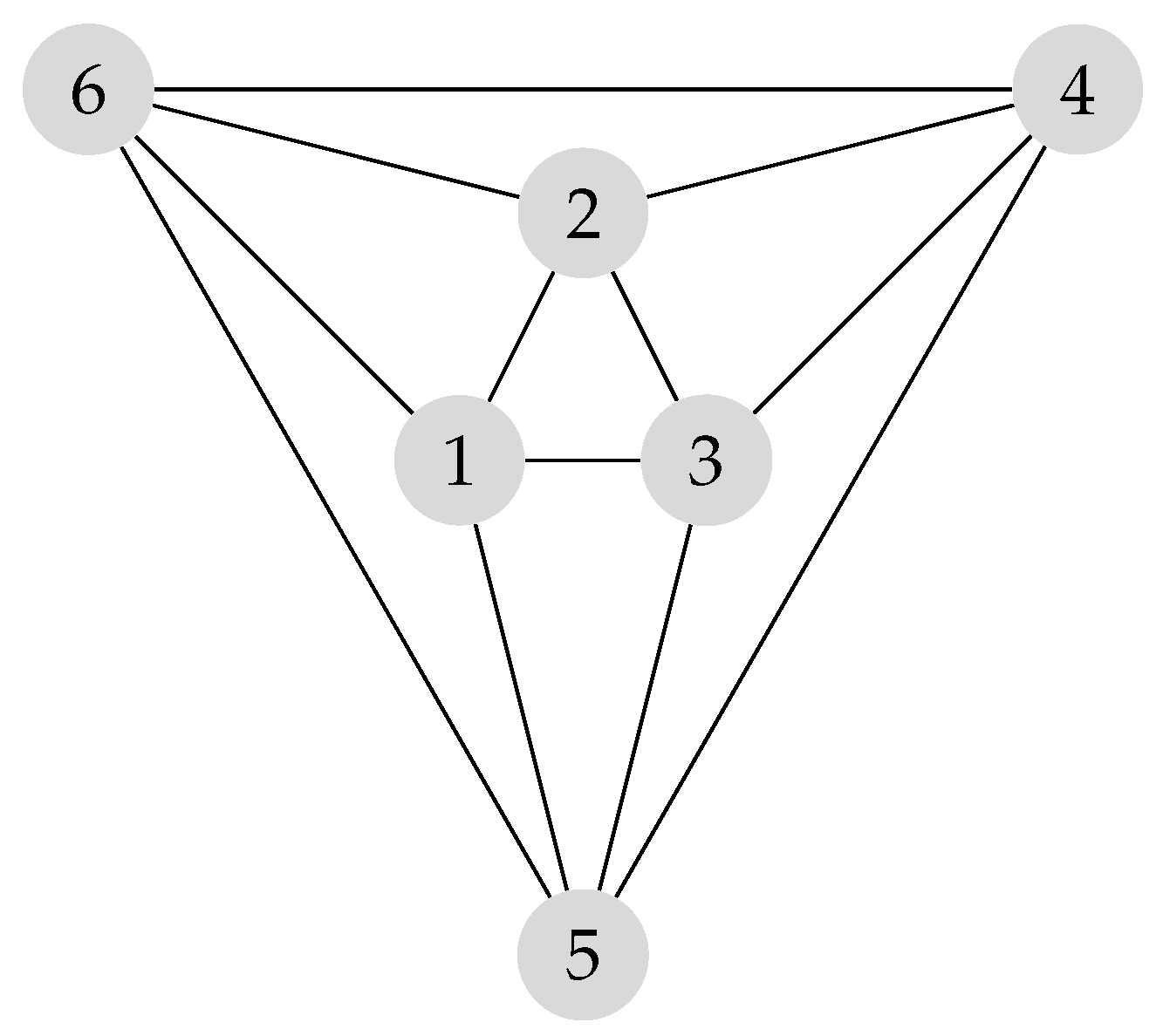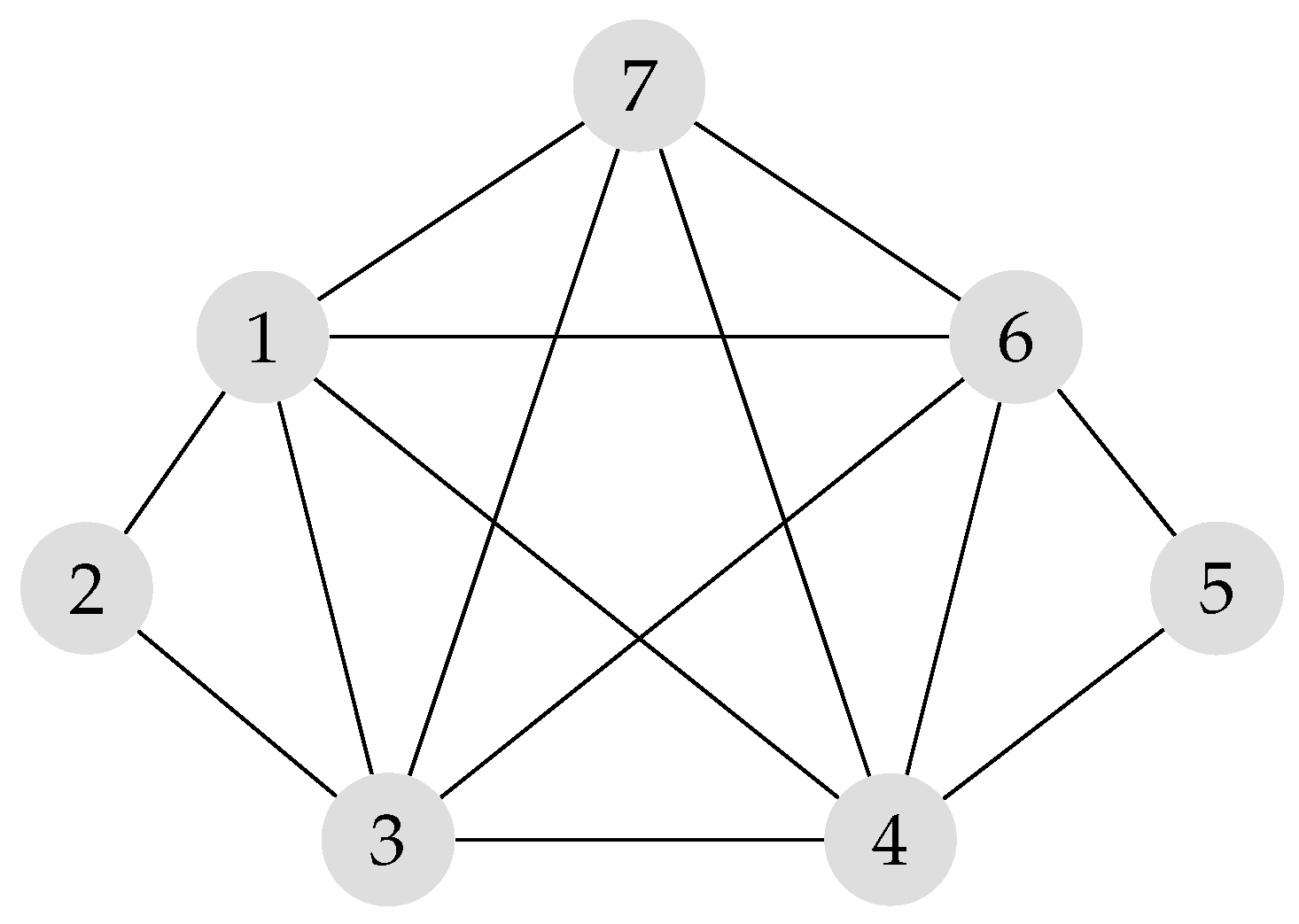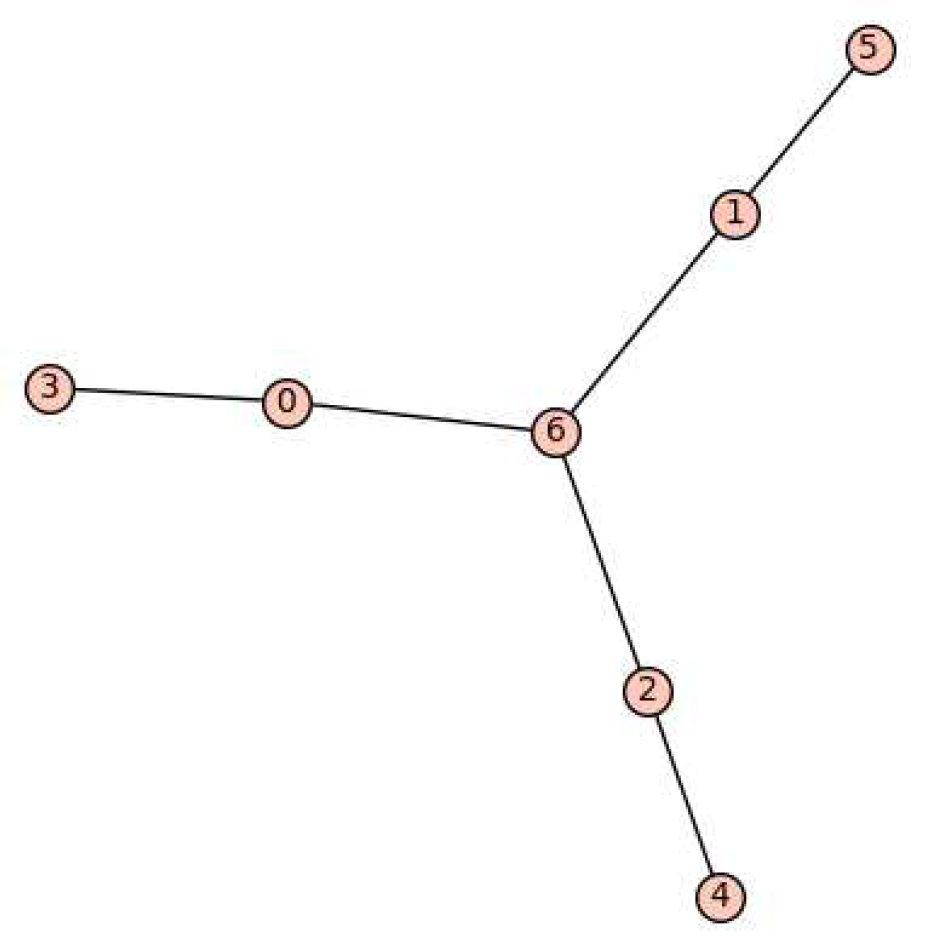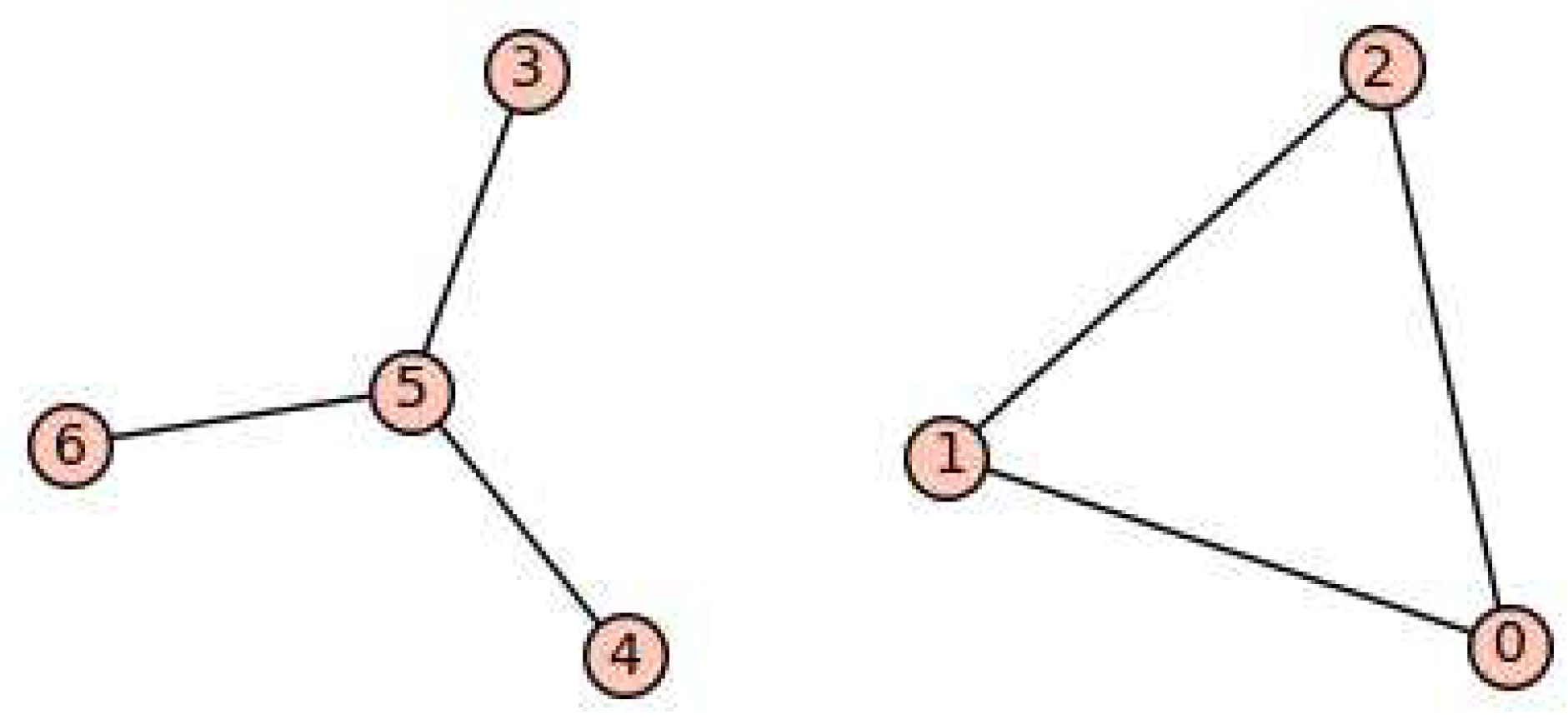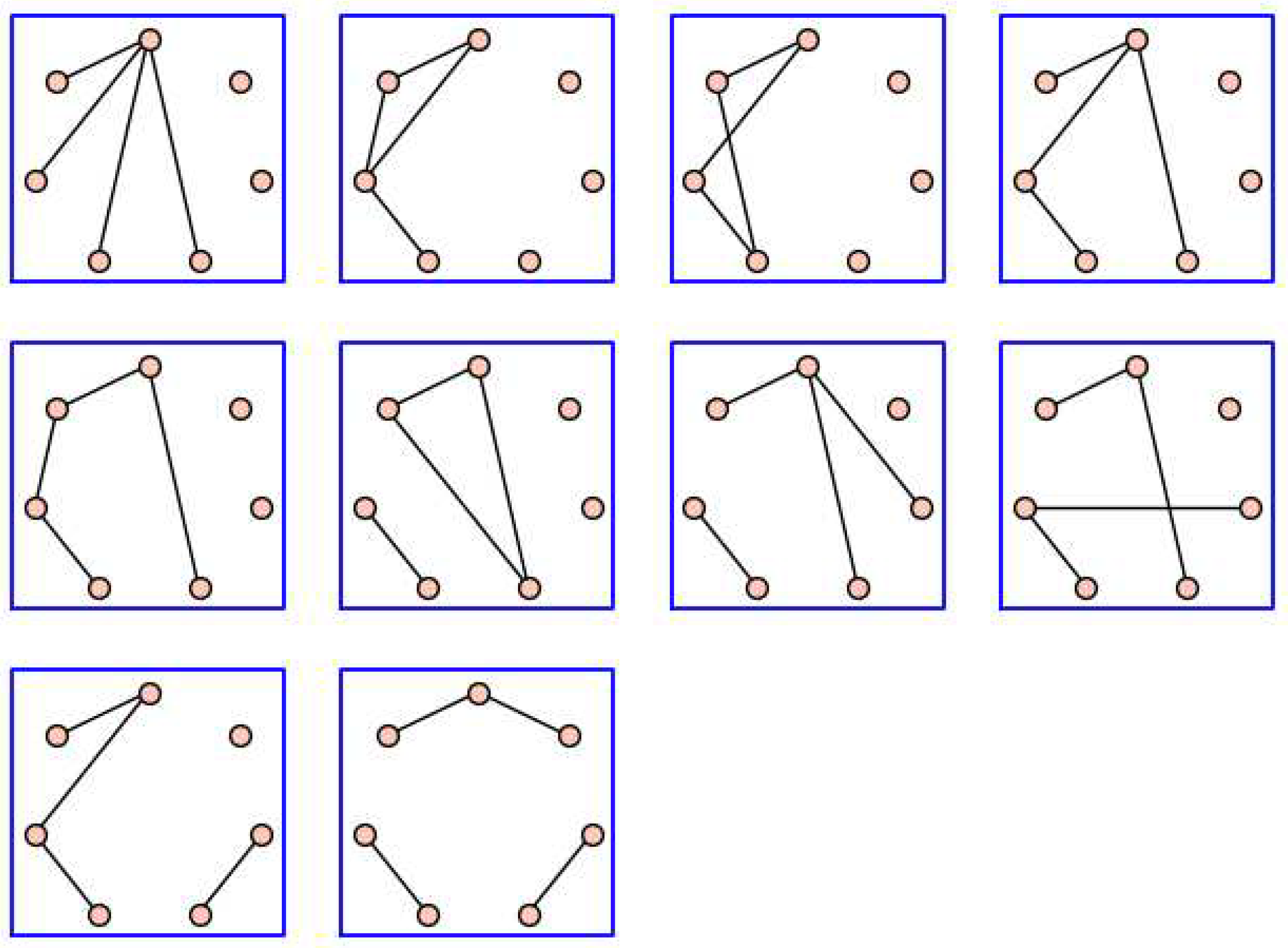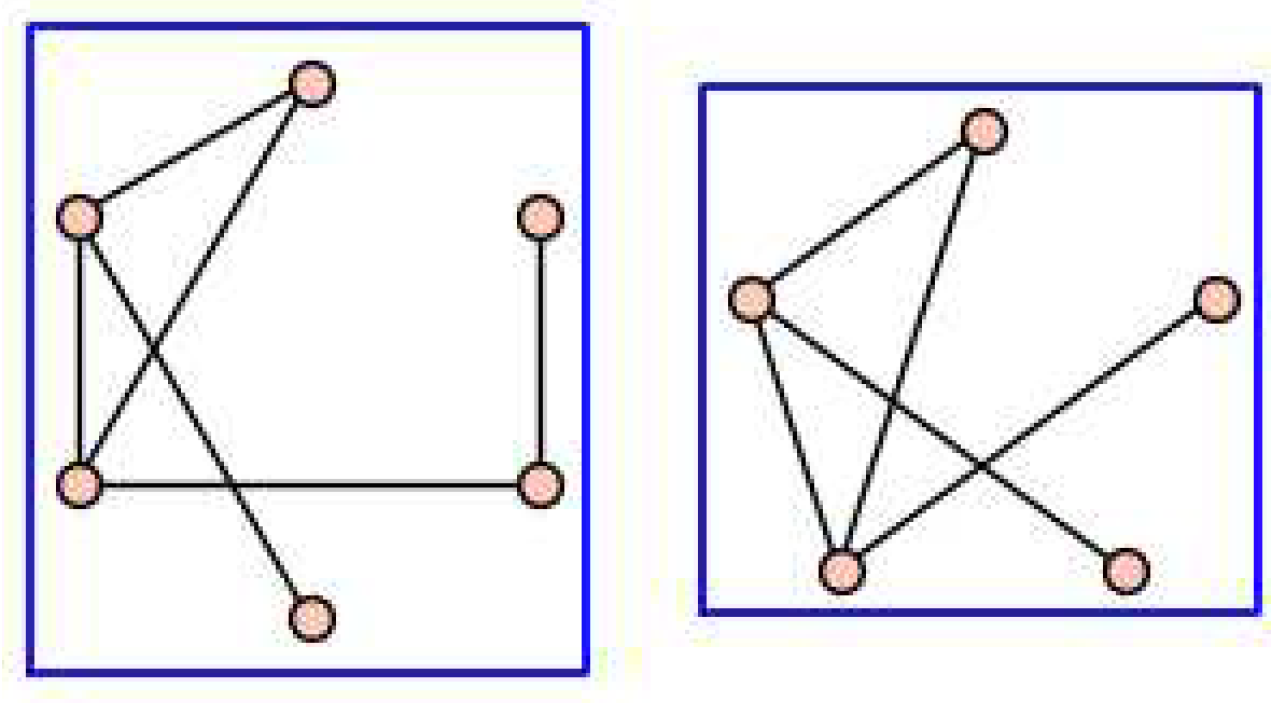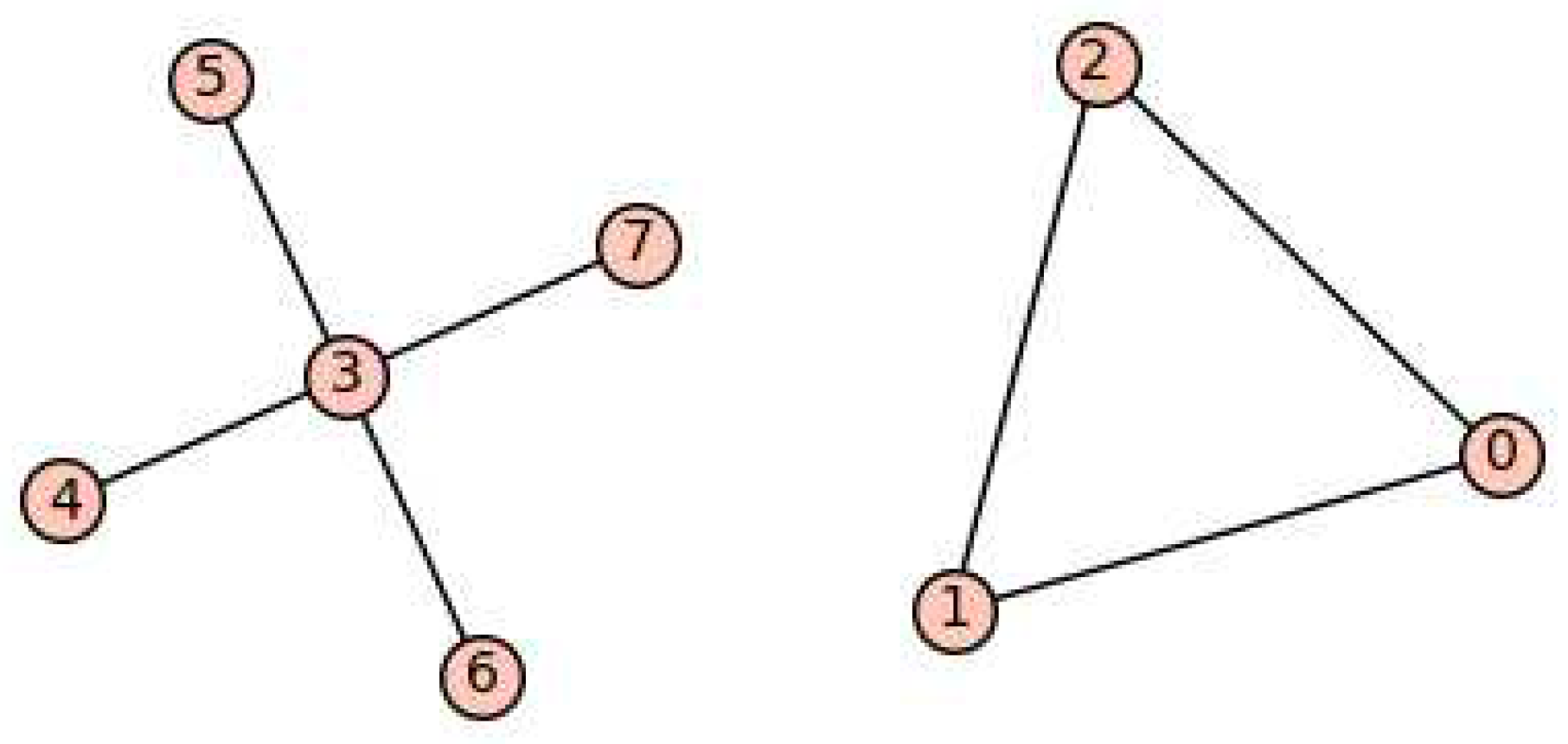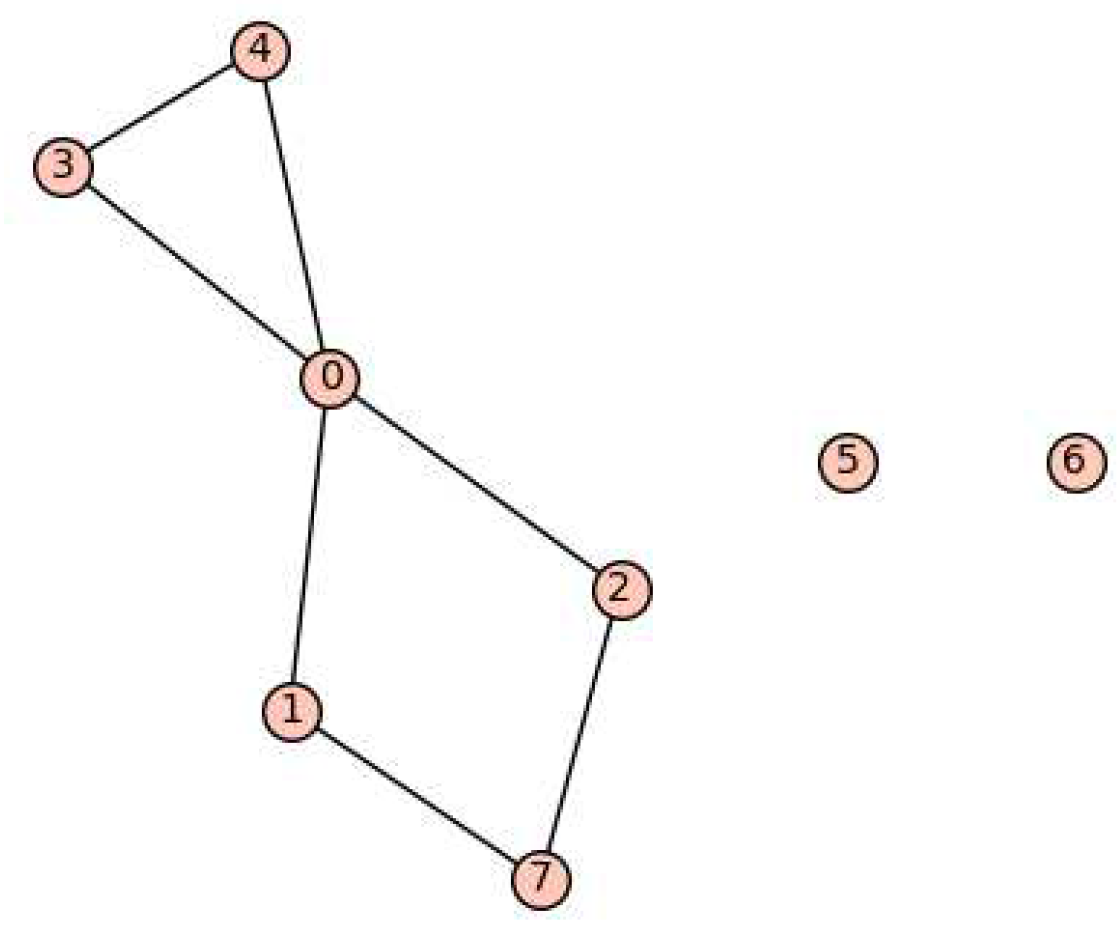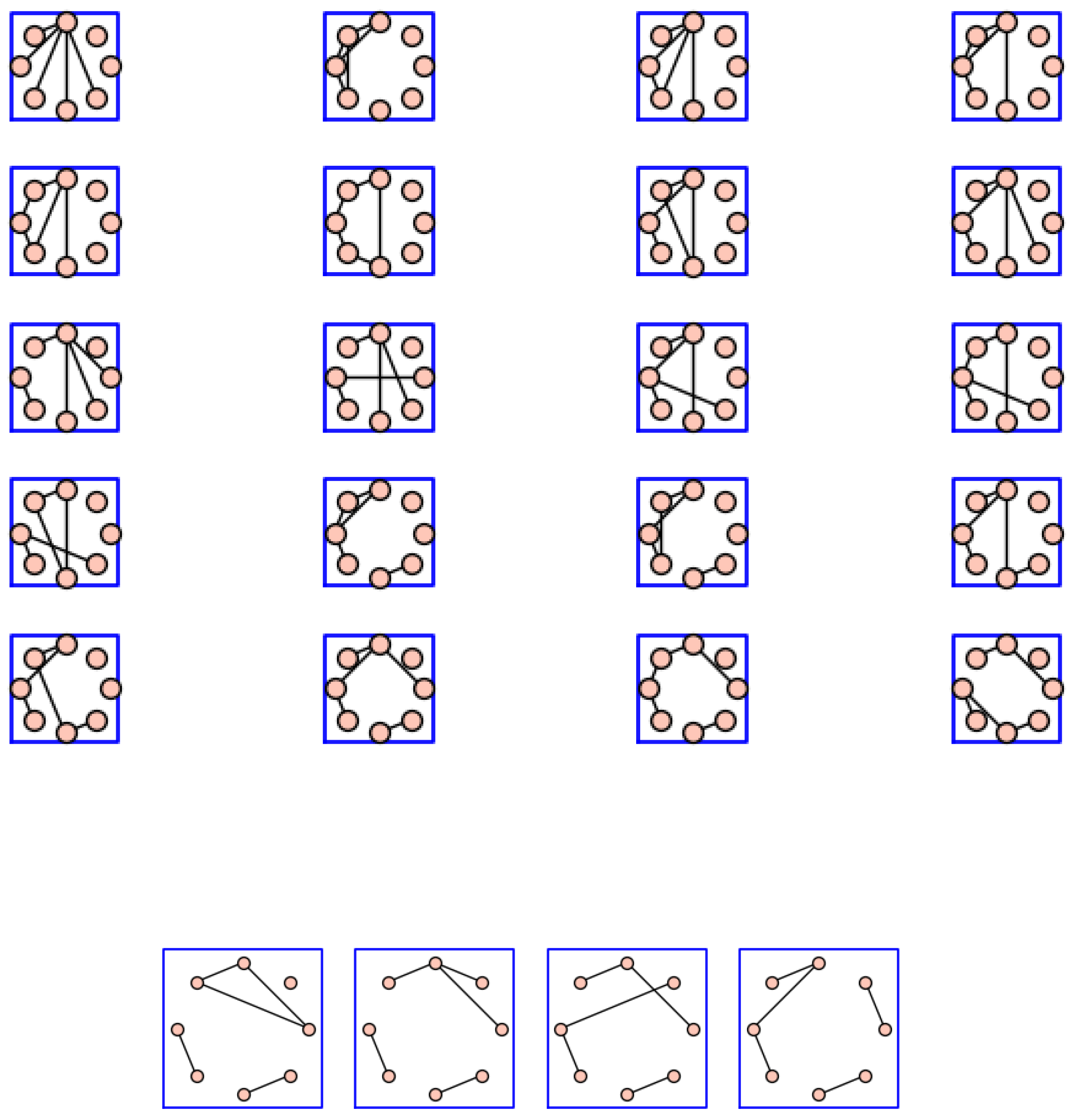In this section, we use of the vertex-clique incidence matrix associated with a clique partition of a graph
G. Recall that for a graph
with the vertex set
and
edges, and for a given clique partition
of
G, consider the matrix
with rows and columns indexed by the vertices in
V and the cliques in
F, respectively, such that the
-entry of
is equal to one if and only if the vertex
i belongs to the clique
. Observe that when
,
as simply the conventional incidence matrix of the graph
G. For each vertex
of the graph
G, we define a new parameter
to be the number of cliques in
F containing the vertex
i, that is,
3.1. Applications of the vertex-clique incidence matrix to graph spectrum
In this section, we develop several results on the spectrum of the graph G and its clique partition graph by the vertex-clique incidence matrix of a graph. Considering with Lemma 2 we conclude that the nonzero eigenvalues of matrices and are the same. This fact leads to the following basic results.
Theorem 3. We have the following.
If , then .
If then for .
If then for .
Recall that if
, then
and
. Combining these equations with Theorem 3 leads to the following well-known result [
11,
12]:
Lemma 6.
Let G be a graph of order n with m edges. Then
In particular if then for , and if then for .
The following result is obtained by applying Theorem 3 for a regular graph G with the clique partition F.
Theorem 4. Let G be a regular graph of order n with a clique partition F of size k.
If then
If then for .
If then for .
Proof. By Theorem 3, if , then , that is, , that is, , that is,
By Theorem 3, if then for , that is, for , that is, for .
By Theorem 3, if then for , that is, for , that is, for . □
Example 5. Considering the complete graph and its minimum clique partition F with only one clique, we have , and . Applying Theorem 4 here we have for , and , that is, is a regular graph. From this with Theorem 4 we arrive at that is, , and by Theorem 4 , for .
Considering the clique partition
for
G isomorphic to the complete tripartite graph
(or
) in
Figure 1, we have
for
and
for
. Then
G is a
regular graph. Moreover,
and by Theorem 4, we have
for
and
for
. From these facts with
, we arrive at
.
Now applying theory of clique partitions and vertex-clique incidence matrices, we obtain a new lower bound for the smallest eigenvalue of a graph.
Theorem 6.
Let G be a graph of order n and let be the largest clique-degree of G with a given clique partition F. Then
Moreover, if equality holds in (4), then and if and G is clique-regular, then equality holds in (4).
Proof. Since
is a positive semi-definite matrix, we have
and by Lemma 1 we arrive at
Considering
we arrive at
, which gives the required result in (
4).
For the second part of the proof, suppose that . Then . This with the relation , gives , that is, . Now we assume that . If then , that is, for , that is, as , that is, with the multiplicity at least . □
Corollary 7. All regular bipartite graphs and all clique-regular graphs with satisfy the equality in (4).
Proof. First we assume that
G is a regular bipartite graph. Since
G is bipartite, we have
for
and
. On the other hand, since
G is regular, we have
. These facts with Theorem 6 gives the fact that all regular bipartite graphs satisfies the equality in (
4).
Next assume that G is a clique-regular graph with . Since , the desired result is obtained by Theorem 6. □
Theorem 6 holds for any clique partition F of G, which leads to the following result:
Corollary 8.
Let G be a graph of order n and let be the largest clique-degree of G with a given clique partition F. Then
where the minimum is over all clique partitions F of G.
The following example shows that for the equality the graph G does not need to be clique-regular.
Example 9.
For the graph G given in Figure 2, we have
This gives for and . The graph is the line graph of the graph of order 6 with 7 edges. Then the smallest eigenvalue of G is while .
In the following we provide a lower bound for the negative inertia of a graph G of order n.
Theorem 10.
Let G be a graph of order n. Then
where minimum is over all clique partitions F of G. Moreover, if , then for .
Proof. If
, then the result in (
6) is obvious. Assume that
is a clique partition of
G with
. In this case, since
and
is positive semi-definite matrix, we have
for
. From this and the fact that
, we have
for
, which gives the desired results. □
The following result is obtained by Theorem 10 and the fact .
Corollary 11. Let G be a graph of the order n and a clique partition F such that . Then
for .
.
Considering F as a minimum clique partition of G, we arrive at the following result:
Corollary 12. Let G be a graph of the order n and clique partition number . If , then
for .
.
For any graph
G of order
n we have [
11]
where
and
are the negative and positive parts of the inertia, respectively of the graph
G. This implies that
In the following we give a sufficient condition under which the equality in (
8) holds.
Theorem 13. Let G be a graph of order n with the independence number and the clique partition number . If F is a clique partition with , then In particular, if , then
Proof.
This fact along with (
8) gives
The assumption that
is equivalent to
. This with (
9) gives the first required result.
Without loss of generality, we may assume that the vertex set is a maximum independent set in G and is a clique of a minimum clique partition containing the vertex . Now in we consider the submatrix induced by the rows and columns corresponding to the vertex set and the clique set , respectively. Obviously, this square principal submatrix is equivalent to the identity matrix of size and hence . Since and using the assumption we arrive at and therefore by the first part of the theorem. □
The following result is obtained from (
5).
Theorem 14.
Let G be a graph of order n and the negative inertia . Let be the ith largest clique-degree of G with a clique partition F. Then for , we have
Equality holds in (10) if G is a clique-regular graph with .
Since is a positive semi-definite matrix, by a similar manner used in the proof of Theorem 6, we obtain the following result.
Theorem 15.
Let G be a graph of order n with a clique partition and let for such that . Then
Equality holds in (11) if G is a clique-uniform graph with .
Proof. Since
is a positive semi-definite matrix, we have
and by Lemma 1, it follows that
Considering
we have
which gives the required result in (
11).
Now assume that G is a clique-uniform graph with . By Theorem 3 (ii) with , we arrive at for . On the other hand, since we have , and consequently . That is, for , that is, with multiplicity at least . □
Theorem 15 holds for any clique partition F of G, which gives the following result:
Corollary 16.
Let G be a graph of order n with a clique partition and let for such that . Then
where minimum is over all clique partitions F of G.
In the case of , we have for by Theorem 3. Since , we get . We summarize this in the next result.
Theorem 17. Let G be a graph of order n and a clique partition F with . Then
for .
.
The following result follows from (
12).
Theorem 18.
Let G be a graph of order n with a clique partition and let for such that . If is the corresponding clique partition graph of G, then for ,
Equality in (14) holds if G is a clique-uniform graph with .
The following concerns the signless Laplacian eigenvalues of a graph.
Theorem 19. Let G be a graph of order n and having a clique partition F with and assume .
If G is a t clique-regular graph, then .
If G is a s clique-uniform graph, then .
Proof. From
Section 3, the signless Laplacian matrix
Q of
G satisfies
. This fact with Lemma 1 gives
, where
and
are respectively, the
ith largest signless Laplacian eigenvalue of
G and the the
ith largest eigenvalue of matrix
. Using the above analysis combined with Theorem 3 and facts
and
implies the desired results in
and
. □
3.2. Applications to energy of graphs and matrices
In this section, using the theory of vertex-clique incidence matrices of a graph, we introduce a new notion of graph energies, as a generalization of the incidence energy and the signless Laplacian energy of the graph. Finally, we present new upper bounds on energies of a graph, its clique partition graph and line graph.
The energy
of the graph
G defined in (
2) has the equivalent expressions as follows [
12]:
where
and
are respectively the positive and the negative inertia of
G. Nikiforov [
31,
32,
33] proposed a significant extension and generalization of the graph energy concept. The energy of an
matrix
B is the summation of its singular values, that is,
Consonni and Todeschini [
10] introduced an entire class of matrix-based quantities, defined as
where
are the eigenvalues of the respective matrix, and
is their arithmetic mean.
According to (
16) and (
17), two types of energies can then be defined for any matrix
B. The incidence energy
of a graph
G is defined to be the energy of the incidence matrix of
G of the type (
16), i.e.,
Similarly,
the vertex-clique incidence energy of G associated with the clique partition F is defined as the energy of the vertex-clique incidence matrix
, i.e.,
From the above and using Lemma 1 we have
and, consequently, we have
with equality if and only if
.
Applying the fact that the diagonal entries are majorized by the eigenvalues of
and by a similar method given in [
13] it can be shown that
Considering the energy of the matrix
of the type (
17) gives
where
. The energy
can be viewed as a generalization of the signless Laplacian energy
of
G which is defined as follows [
1]:
Due to the similarity of the definitions for signless Laplacian energy
and
it follows that in most cases, results derived about
can be generalized to
. For example, from Lemma 2.12 in [
12] for
, we obtain the following:
where
is the largest positive integer such that
.
Using a method similar to the proof of Corollary 5 in [
35] for
, we have
In the next result, we show that for a clique-regular graph G associated with a clique partition F, .
Theorem 20. If G is a clique-regular graph associated with a clique partition F, then .
Proof. Suppose that
G is
t clique-regular. Then
□
Note that for any t clique-regular graph G, we have . Next we show that for a clique-uniform graph G we have .
Theorem 21. If G is a clique-uniform graph with the clique partition graph , then .
Proof. Suppose that
G is a
s clique-uniform graph. Then
□
Note that for any
s clique-uniform graph
G with the clique partition graph
, we have
In [
12] Theorem 3.3, a relation between the energy of the line graph
and the signless Laplacian energy
of
G is given. In the following, we generalize this result by using the notion of clique partition of a graph and we provide a comparison between the energy of the clique partition graph
of
and
. For this we need the following lemma, which is obtained from Theorem 3 and is a generalization of Lemma 6.
Lemma 7.
Let G be an s clique-uniform graph of order n associated with a clique partition F where . Then
Theorem 22. Let G be an s clique-uniform graph of order n associated with a clique partition F where .
If , then .
If , then .
If , then .
Proof. Let
. By Lemma 7 we have
On the other hand, from (
15) we have
Recall that
is the largest positive integer such that
and let
. Again by Lemma 7 we have
On the other hand, by (
19) and Lemma 7 we have
From (
15) with the above equation we have
If
, then
by
and
, i.e., if
, then
. It suffices to show that if
, then
. Indeed, if
, then
From the fact with Lemma 7 we have □
In the following, we present a new upper bound for the energy of a graph G.
Theorem 23.
Let G be a graph of order n and the negative inertia and let be the largest clique degree associated with the clique partition F, for . Then
where the minimum is given over all clique partitions F of G. Equality holds if G is a clique-regular graph associated with a minimum clique partition of size .
Proof. From (
15) and (
10) we have
where
is
largest clique-degree of
G associated with a clique partition
F. Since this upper bound is valid for any clique partition of
G, we select the optimal value, namely,
. The second part of the proof follows directly from Theorem 14. □
Theorem 24.
Let G be a graph of order n with the vertex degrees . Then
where .
Proof. Considering the fact
for
along with Theorem 23 gives
On the other hand, the Laplacian matrix
of
G is a positive semi-definite matrix, so
. From this with Lemma 1 we obtain
for
. Then
. Using the previous inequality with (
20) completes the proof. □
From Theorem 23 with (
7) we obtain the following upper bound for the energy of
G:
where
is the independence number of the graph
G. By (
15) and (
14) and applying a similar method done for the proof of Theorem 23, we obtain the next result.
Theorem 25.
Let G be a graph of order n with a clique partition and let for such that . For the clique partition graph of G, we have
Equality holds if G is a clique-uniform graph associated with a minimum clique partition of size .
Next, we present an upper bound for the energy of the line graph with a full characterization of the corresponding extreme graphs.
Theorem 26.
Let G be a graph with the line graph . Then
Equality holds if and only if G is a graph with connected components for with and , and possibly some isolated vertices or single edges. Further, each non-bipartite connected component satisfies and , and each bipartite connected component is either a 4-cycle or satisfies and .
Proof. As previously noted, if the clique partition
F of
G is as same as the edge set
E of
G, then
for
and
. This using Theorem 25, we have
which gives the desired result in (
21).
To characterize these extreme graphs in (
21), we assume equality holds in (
22). Then all negative eigenvalues of
must be
by (
22). We then consider the following two cases:
G is connected. First, assume that . If G is non-bipartite, then by Lemma 6, for and as . Since must be nonnegative, we have . Otherwise G is bipartite and by Lemma 6 along with the fact , for and as . Since must be nonnegative, it follows that . Next, assume that . Since all negative eigenvalues of are equal to , we have . If , then and then is the cycle graph of order 4. Otherwise , and , that is, , which is a contradiction as G is connected. Finally, assume that . Since G is connected it must be a tree and hence . In this case we have , that is, , which again leads to a contradiction.
Assume G is disconnected. Since isolated vertices and single edges do not affect the negative inertia of , we may assume that G has connected components along with the possibility of some isolated vertices and single edges. Now each connected component of G can be characterized by the first case, and the proof is complete. □
